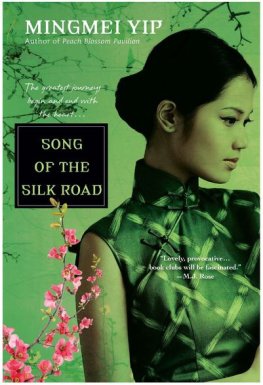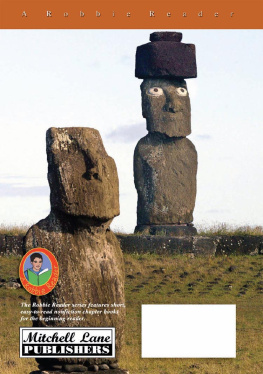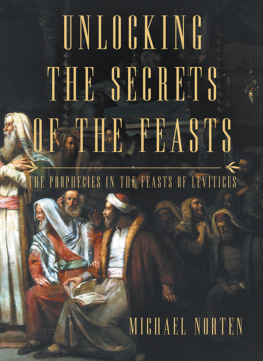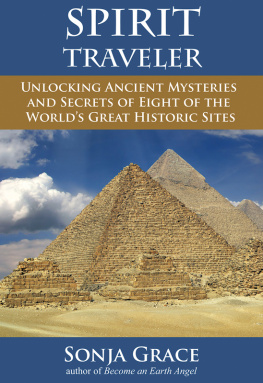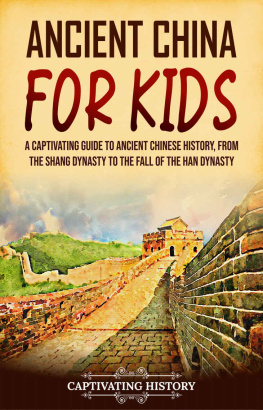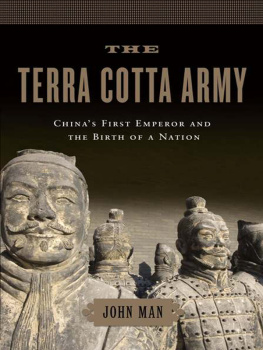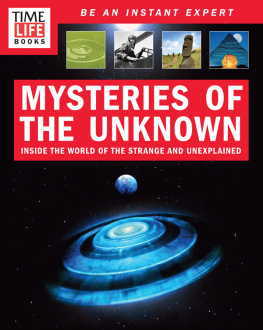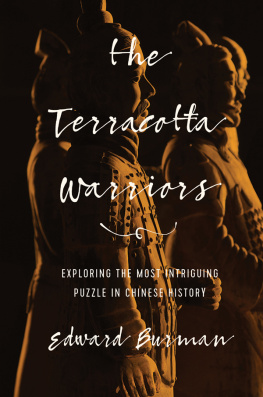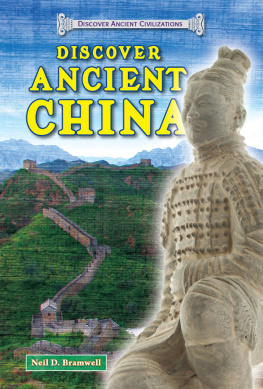TABLE OF CONTENTS
CHAPTER ONE
A BURIED ARMY EMERGES
Farmers digging in the dark pit were frightened. For centuries they had heard aboutevil spirits that lurked beneath the soil in this field. Strange things had beenseen here. Faces were said to have loomed suddenly out of the dirt when people haddug too deeply. Grasping hands had sometimes appeared. People had long whisperedabout these ghosts. Some thought they might be the guardians of the ancient emperor,whose tomb was nearby. Maybe it was the long-dead emperor himself!
LOCATION OF TERRACOTTA ARMY
The Terracotta Army is located near Xian, southwest of Beijing.
In March 1974 the farmers were digging a well near Xian, China. About 12 feet (3.7meters) down, they struck something. They cleared the dirt from around the object.A face appeared! Terrified, they soon saw the face was not that of a ghost at all.It was an amazingly real-looking head. They dug deeper and found otherlarge pieces of hard baked clay. These appeared to be the broken parts of an ancientwarrior statue.
The farmers were excited. This discovery was too important to keep secret!
terracotta a brown-orange clay
Workers gradually uncovered terracotta figures.
AN UNDERGROUND ARMY
Word of the amazing discovery spread fast. Soon from all over Chinabegan to arrive. They were excited to see the terracotta pieces the farmers had found.The statue pieces were different from anything found in China before. The head appearedto be of an ancient warrior. Tests showed that the terracotta was more than 2,000years old. The clay pieces had once been brightly painted, but the color faded quicklyonce exposed to light and air.
archaeologist a scientist who studies how people lived in the past by analyzing theirartifacts
Archaeologists unearth more terracotta warriors in 2009. Like during past excavations,theyneeded to be very careful not to damage the statues.
The archaeologists wondered if there might be more statues buried in the field. Theydug many test holes in the ground. Nearly every place they looked had more statuesand broken bits of terracotta. The buried statues were those of warriors in fullbattle gear. The archaeologists also found pieces of real weaponsswords, arrows,spears, and .
After months of careful digging, they found thousands of life-size warrior statuesburied in the field. But who could have made this incredible armyand why?
CROSSBOWS
Crossbows have been used as weapons in hunting and warfare for thousands of years.The first crossbows were invented in China about 400 BC, and possibly as early as2000 BC. Crossbows are smaller and easier to use than bows and arrows. Crossbowsspread throughout the world and changed the way people fought wars.
crossbow a weapon based on the bow and arrow
CHAPTER TWO
REBUILDING AN ARMY
Months passed, and the dig grew wider and deeper. Searchers found in fourpits. The pits had once been rooms in a building buried under 6 feet (1.8 m) of soil.The floors of the pits had been paved with bricks. Beneath the bricks were pipesto drain away any water that entered the rooms.
There were thousands of warrior statues standing in the pits. The workers also discoveredpieces of terracotta horses and .
Archaeologists have pieced together a bronze chariot from fragments.
But the number of warrior statues surprised the workers most. The warriors seemedto be everywhere. Nearly all of them were broken into small pieces. It took archaeologistsand trained workers many months just to put one statue back together. Each ruinedwarrior had to be rebuilt by hand, like a huge jigsaw puzzle.
artifact an object used in the past that was made by people
chariot a light, two-wheeled cart pulled by horses
PIECES OF A PUZZLE
About 2,000 Terracotta warriors have been reassembled. The rest are still in piecesor lie buried. Experts think about 8,000 Terracotta warriors may have once stoodin the pits.
WARRIORS OF ALL KINDS
Even before the warriors were put back together, researchers could tell that eachone looked different. Some seemed older than others. Eyes and noses were differentshapes. Each statue had its own hairstyle. There were many varieties of clothes andshoes on the warriors. Some smiled, while others seemed angry. Some had mustachesand beards. Others looked too young to have facial hair at all. Their sizes and poseswere all slightly different as well.
Terracotta warriors
There were several kinds of warriors. The clothing and weapons on the statues showedwhat role each soldier played in the army. Statues of many common soldiers wore , which helped protect ancientChinese warriors in battle. Warrior statues with longer beards were placed behindthe ranks of soldiers. These statues were of older warriors, maybe officers. Mostof the soldiers were standing, but some were kneeling. Many of the kneeling statueswere archers designed to hold real bows and arrows or crossbows.
Most of the Terracotta Army figures held actual weapons. The weapons were not made of terracotta. They slowly fell apart after being exposed to moisture in the ground.
tunic a long, loose-fitting shirt
fishscale armor a kind of armor worn in ancient times made up of overlapping platesthat looked like the scales of a fish
MORE MYSTERIES IN THE PITS
Years passed and the archaeologists kept digging. The search area stretched out acrossthe field for more than 1 mile (1.6 kilometers). Everywhere they dug, they foundmore and more statues. One of the pits had statues of the armys highest officers.Their clothing was fancier, and these statues were taller than most of the others.Together a team of scientists searched for answers about the warriors buried in thepits.
Terracotta Army officer
MOLDS
Scientists have learned that all of the warrior statues were made from molds. Wetclay was put into wooden forms to make parts of the warriors bodiesarms, legs,and heads. Then skilled artists took the clay out of the molds and added certaindetails to each piece. This was done by hand. The artists wanted to make each warriordifferent. All of the parts were then fired in . The artists applied a specialcoating that sealed the terracotta pieces together into a solid statue. The finalstep was to paint the statues with bright colors.


